| DF-21C Missile Deploys to Central China
DF-21C导弹在中国中部部署 Date:2010-11-14 Source:Fas By:Hans M. Kristensen Viewed: |
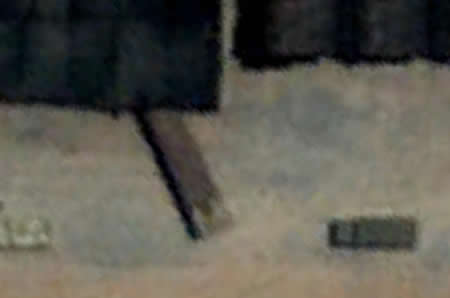 |
| China’s new DF-21C missile launcher shows itself in Western China. Image: GoogleEarth |
By Hans M. Kristensen
作者 汉斯·克里斯滕森
The latest Pentagon report on Chinese military forces recently triggered sensational headlines in the Indian news media that China had deployed new nuclear missiles close to the Indian border.
五角大楼最近出台的中国军力报告称中国新型东风-21C陆基移动式导弹部署在中印边境地区,这一消息使印度新闻媒体大为震动。
The news reports got it wrong, but new commercial satellite images reveal that launch units for the new DF-21C missile have deployed to central-western China.
不过,最新报告指出五角大楼这一消息有错,新卫星图片显示,新型东风-21C导弹的发射场位于中国中西部地区。
New DF-21C Launch Units
新东风-21C导弹发射场
Analysis of commercial satellite imagery reveals that launch units for the road-mobile DF-21C medium-range ballistic missile now deploy several hundred kilometers west of Delingha in the western part of central China.
商业卫星图片分析显示,东风-21C陆基移动式中程弹道导弹的发射场位于距中国西部地区德令哈以西数百公里处。
| Location of DF-21C Launch Units |
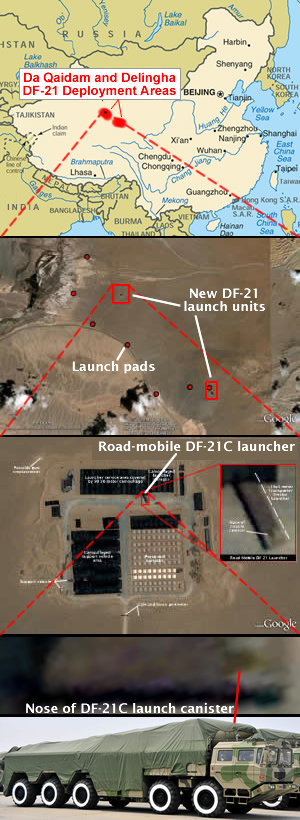 |
| For larger versions of the two middle satellite images, click here and here. Images: GoogleEarth and chinamil.com.cn |
In one image, taken by the GeoEye-1 satellite on June 14, 2010, two launch units are visible in approximately 230 km west of Delingha. The units are dug into the dry desert slopes near Mount Chilian along national road G215. Missile launchers, barracks, maintenance and service units are concealed under large dark camouflage, which stands out clearly in the brown desert soil.
GeoEye-1卫星拍摄于2010年6月的一张图片显示,两个东风-21C导弹发射场出现在德令哈以西230公里处,位于国道G215线旁。导弹发射车、兵营、维护保养部队隐藏在大型深色伪装之下,在灰棕色的沙漠里异常显眼。
The eastern launch unit (38° 6’37.75″N, 94°59’2.19″E) includes a central area with red barracks clearly visible below the camouflage, which probably also covers logistic units such as communications vehicles, fuel trucks, and personnel carriers. An 88×17 meter garage of brown camouflaged probably covers the launcher service area, with five 15-meter garages nearby probably housing the TELs. Approximately 130 meters north of the central area, brown camouflage and dirt barriers possibly house the unit’s remote fuel area. Two launch pads are visible, one only 180 meters from the main section, the other on the access road leading to national road G215.
位于东侧的导弹发射场(38°6’37.75″N,94°59’2.19″E)中央区很明显包括藏在掩体内的兵营,可能还包括例如通信车、加油车、运兵车等后勤部队。88×17米的褐色伪装车库可能内含发射服务区,5个15米长的车库可能内含运输-架设-发射装置。中央区北部约130米处的褐色伪装和泥土掩体可能是发射场的燃料区。该发射场还有两个发射台,其中一个距离主区180米,另外一个位于通往进入G215国道的道路上。
The western launch unit (38° 9’32.82″N, 94°55’37.02″E) is located approximately 7 km further west about 2.4 km to the north of national road G215. The unit consists of four sections: personnel barracks (almost 100 with more possibly under camouflage); a logistic vehicles area; a launcher service area with a 90×33 meter camouflage and four garages; and what is possibly a remote fuel storage area. A launch pad is located along the access road close to G215.
西侧的发射场(38°9’32.82″N,94°55’37.02″E)还要以西7公里,距G215国道约2.4公里。该发射场由4个部分构成:兵营(伪装下有近百或更多房舍)、后勤车辆存放区、拥有一个90×33米伪装和4个车库的发射服务区、一个可能是燃料区的部门。在通过G215国道附近公路旁边有一个发射台。
The satellite image shows what appears to be a DF-21C entering or leaving the camouflaged launcher service area. The characteristic nose cone of the missile canister embedded into the rear of the driver cockpit is clearly visible, with the rest of launcher probably covered by a tarp.
卫星图片显示出一枚东风-21C导弹正在进或出发射服务区。这是首次东风-21C在部署区内被确认。
This is, to my knowledge, the first time that the DF-21C has been identified in a deployment area. In 2007, I used commercial satellite images to describe the first visual signs of the transition from DF-4 to DF-21 at Delingha. A second article in 2008 described the extensive system of launch pads that extends west from Delingha along national road G215 past Da Qaidam.
2007年,克里斯滕森曾利用商业卫星图片发现了德令哈东风-4向东风-21导弹过渡的迹象。在两个发射场附近5英里范围内有5个导弹发射台。
There are five launch pads within five miles of the two launch units, with dozens other pads along and north of G215 in both directions.
而且,在G215国道双向沿线和北部还有十几处其他发射台。
More Invulnerable but with Limits
虽更固若金汤,但仍有缺陷
China’s ongoing modernization from old liquid-fuel missiles to new solid-fuel missiles is getting a lot of attention. The new systems are more mobile and thus less vulnerable to attack. Yet the satellite images also give hints about limitations.
中国正在进行现代化,从旧的液体燃料导弹升级为新式固体燃料导弹,此举正在引起大量关注。新系统更机动,因此较不易受到袭击。然而,卫星图片也显示出了中国导弹的局限性。
First, the launch units are large with a considerable footprint that covers an area of approximately 300×300 meters. They are manpower-intensive requiring large numbers of support equipment. This makes them harder to move quickly and relatively easy to detect by satellite images.
首先,发射场规模过大,可覆盖约300×300平方米的范围。这些发射场属人力密集型地区,而且需要大量配套设备。这使得他们难以快速移动,而且通过卫星图片较易被发现。
| DF-21C Launch Unit on the Move |
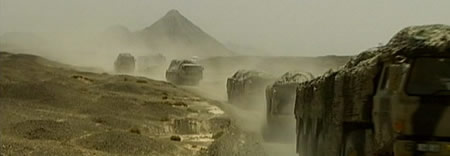 |
| The DF-21C medium-range ballistic missile may be more mobile and harder to target than older missiles, but it still relies on a large support unit that can be detected. Image: CCTV-7 |
.
Individual launchers of course would be dispersed into the landscape in case of war. But although the road-mobile launcher has some off-road capability, it requires solid ground when launching to prevent damage from debris kicked up by the rocket engine. As a result, launchers would have to stay on roads or use the pre-made launch pads that stand out clearly in high-resolution satellite images. Moreover, a launcher would not simply drive off and launch by itself, but need to be followed by support vehicles for targeting, repair, and communication.
在战争情况下,发射装置可分散部署。然而,虽然道路机动发射装置有一定的越野能力,但在发射时也需要有坚实的地面,以防止火箭发动机激起的碎片造成破坏。因此,发射装置必须停在公路上,或使用可被高分辨率卫星图卫识别的预制发射台上。此外,发射装置本身并不能移动和发射,其还需有用来瞄准、维修和通信的支援车辆。
Indian News Media (Mis)reporting
印度新闻媒体错误报道
The deployment of DF-21 missiles caused constipation in Indian last month after the 2010 Pentagon report of Chinese military forces stated that China is replacing DF-4 missiles with DF-21 missiles to improve regional deterrence. The statement was contained in a section dealing with Chinese-Indian affairs and was picked up by the Press Trust of India, which mistakenly reported that the Pentagon report stated that, “China has moved advanced longer range CSS-5 [DF-21] missiles close to the border with India.” The Times of India even wrote the missiles were being deployed “on border” with India.
上个月东风-21导弹的部署引起了印度的不安,此前2010五角大楼关于中国军力的报告称,中国正在用东风-21导弹替换东风-4导弹,以提升地区威慑力。该声明出现在与中印事务有关的章节中。《印度新闻信托社》对其进行了报导,其错误地报道称,五角大楼报告中提到:“中国已将先进增程东风-21导弹部署至印度边境附近”。《印度时报》甚至写到,导弹部署在印度“边界上”。
| India News Media Makes a Bad Situation Worse |
 |
| The India news media significantly misreported what the Pentagon report said about the Chinese DF-21 deployment. Not the finest hour of Indian journalism. |
.
Not surprisingly, the misreporting triggered dramatic news articles in India, including rumors that the Indian Strategic Forces Command was considering or had already moved nuclear-capable missile units north toward the Chinese border in retaliation.
并不奇怪,错误报道在印度激起了很多戏剧性新闻文章,甚至有谣言称印度战略司令部正在考虑或已经将核导弹部队向北推进至中国边境进行反击。
The Pentagon report, however, said nothing about moving DF-21 missiles close to or “on” the Indian border. Here is the actual statement: “To improve regional deterrence, the PLA has replaced older liquid-fueled, nuclear-capable CSS-3 intermediate-range ballistic missiles with more advanced and survivable solid-fueled CSS-5 MRBM….” The statement echoes a statement in the 2009 report: “The [People’s Liberation Army] has replaced older liquid-fueled nuclear-capable CSS-3 [DF-4 medium-range ballistic missiles] MRBMs with more advanced solid-fueled CSS-5 MRBMs in Western China.”
然而,五角大楼的这份报告并未提及将东风-21导弹靠近或“部署在”印度边界之事。该报告采用的实际说法是:“为增强区域威慑,解放军已经用更先进且存活性更强的固体燃料CSS-5中程弹道导弹,替代了旧式液体燃料可携带核弹头的CSS-3中程弹道导弹。”这一说法在2009年度报告中说法相似:“解放军已经用部署在中国西部更先进的固体燃料CSS-5中程弹道导弹,替代了旧式液体燃料可携带核弹头的CSS-3中程弹道导弹(DF-4中程弹道导弹)。”
The sentence appears to describe the apparent near-completion of China’s replacement of DF-4 missiles with DF-21 missiles, probably at two army base areas in Hunan and Qinghai provinces, a transition that has been underway for two decades. The two deployment areas are each more than 1,500 kilometers from the Indian border.
这句话似乎是在说中国几乎完成用东风-21导弹替换东风-4导弹(可能是在湖南和青海省的军事基地地区),此过渡已经进行了二十年。这两个部署地区距印度边界都大于1500公里。
Range Confusion
射程混乱
The unclassified ranges of Chinese DF-21 versions published by the U.S. intelligence community are 1,770+ km (1,100+ miles) for the two nuclear versions (DF-21, CSS-5 Mod 1; and DF-21A, CSS-5 Mod 2). The DF-21A appears to have an extended range of 2,150 km. The dual-capable “conventional” DF-21C has a maximum range of 1,770 km, and the yet-to-be-deployed DF-21D anti-ship missile has a shorter range of 1,450+ km. Private publications frequently credit the DF-21D with a much longer range (CSBA: 2,150 km; sinodefence.com and Wikipedia: 3,000 km).
目前,美国情报界已公布射程的中国东风-21的变型版是射程在1770公里以上的两款核导弹:DF-21(CSS-5Mod1)和DF-21A(CSS-5Mod2)。其中,DF-21A增程型导弹的射程似乎达到了2150公里。此外,具备双重能力的“常规”东风-21C的最大射程为1770公里,而尚未部署的东风-21D反舰导弹的射程相对较小,在1450公里以上。不过,一些民营出版物经常认为,东风-21D拥有更大的射程:美国战略与预算评估中心(CSBA)认为其射程是2150公里,今日中国防务与维基则称其射程是3000公里。
DOD maps are misleading because they depict missile ranges measured from the Chinese border, as if the launchers were deployed there rather than at their actual deployment areas far back from the border. The 2008 report, for example, includes a map essentially showing China’s border extended outward in different colors for each missile range. The result is a DF-21 range of about 3,000 km if measured from the actual deployment areas.
国防部有关导弹射程的说法之所以具有误导性,是因为他们从中国国界开始计算导弹的射程,就好像这些导弹的发射装置部署在中国国界地区,而不是位于距离国界非常远的实际部署地。例如,2008年的报告中包含了一张地图,上面从中国国界开始向外、以不同的颜色表示不同导弹的射程。其结果是,如果实际部署地算起,东风-21的射程约为3000公里。
| DF-21 Range According to 2008 Pentagon Report |
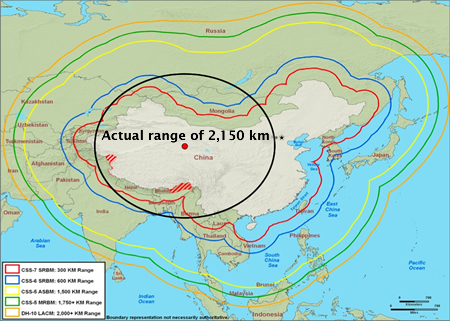 |
| The 2008 Pentagon report on China’s military forces misrepresents missile ranges. |
.
The 2010 report is even worse because it shows the ranges without the border contours as circles but measured from the most extreme border position. The result is a map that is even more misleading, suggesting a DF-21 range of as much as 3,500 km from actual deployment areas. The actual maximum range is 2,150 km for DF-21A (CSS-5 Mod 2), and 1,770 km for the DF-21C.
2010年的报告更糟糕,因为它在说明导弹射程时,没有将国界轮廓设定为圆圈,而是以国界最末端的地方开始计算。结果制成了一副更具误导性的地图,该地图显示东风-21从实际部署地的射程远达3500公里。而东风-21A(CSS-5Mod2)的实际最大射程为2150公里,东风-21C的实际最大射程为1770公里。
| DF-21 Range According to 2010 Pentagon Report |
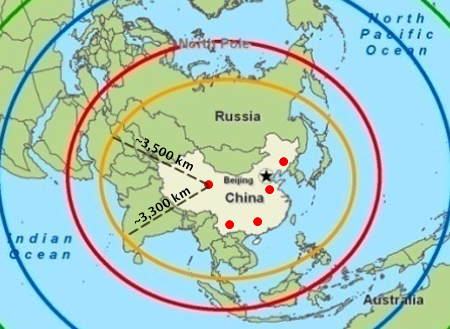 |
| The 2010 Pentagon report on Chinese military issues greatly exaggerates the reach of the DF-21 by drawing a ring around China that doesn’t reflect actual deployment areas. |
.
Although a DF-21 launcher could theoretically drive all the way up to the border to launch, the reality is that DF-21 bases and roaming areas are located far back from the border to protect the fragile launchers from air attack. DOD maps should reflect that reality.
尽管东风-21导弹的发射装置在理论上可以移动到国界地区进行发射,但实际上东风-21导弹的基地以及漫游地区都与国界地区相距甚远,中国这样做是为了保护脆弱的发射装置不会遭到空袭。而国防部的地图应该将这一事实反应出来。[中文译文来自东方网军事]
上一篇:Chinese Jammer Finds Work 下一篇:China’s New AG600 Amphibious Airplane Plans for Sea Trials
| China's Navy Fujian Aircraft Carrier Tests Electromagnetic Catapult Echoing US Na
中国海军福建航空母舰测试电磁弹射器,与美国海军的进步相呼应 |
| Recent footage released by Chinese state media shows the first test of the electromagnetic catapult launch system on China's most advanced aircraft carrier, the Fujian. ... [2024-09-14] |
| Mikoyan-41 6th-gen fighter may never leave drawing board
米格-41第六代战斗机可能永远不会离开绘图板 |
| The MiG-41, also known as the PAK DP, is Russia's sixth-generation stealth interceptor currently under development to replace the aging MiG-31.... [2024-09-03] |
| Rare Chinese Y-9LG ELINT Aircraft Spotted In Thailand
中国罕见的Y-9LG ELINT飞机在泰国被发现 |
| PLAAF Y-9LG (High New 13) spotted in Thailand during exercise Falcon Strike. ... [2024-09-02] |
| Focus China's Strategic Preparations for Next-Generation Drone Warfare
聚焦中国下一代无人机战争的战略准备 |
| For years, China has established itself as a key player in the development of military technologies, particularly in the drone sector. ... [2024-08-24] |
